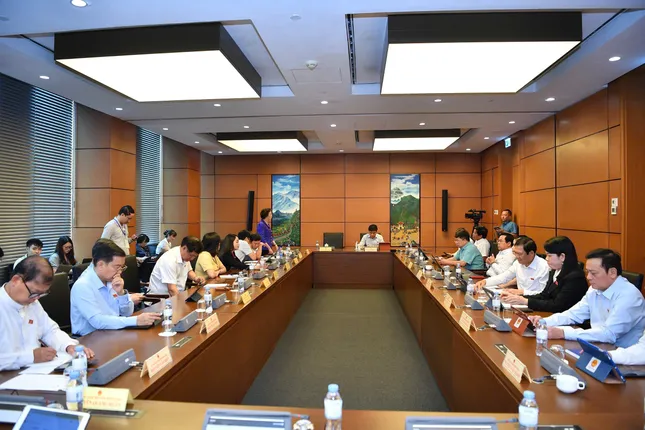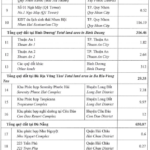“An Enormous Task, Yet We Persevered”
On the morning of June 11th, during a group discussion, Minister of Home Affairs Pham Thi Thanh Tra affirmed that we are witnessing a synchronized and thorough revolution in organizational restructuring. This is a comprehensive transformation, not only in terms of territorial organization but also in institutional, cultural, and economic spaces.
In this crucial phase, Minister Tra noted the remarkable unity and consensus within the political system and among all social classes and the people, which is something to be cherished. Despite the urgent pace and demanding timeline, the implementation process has been cautious, meticulous, well-planned, scientific, rigorous, and assured.

Minister of Home Affairs Pham Thi Thanh Tra. Photo: Nhu Y.
“As insiders, we all feel like we are moving towards a space of change, promoting development, with motivation, faith, and expectations. The entire political system is making efforts. Despite the enormous task, we persevered because of our strong belief, high expectations, and political determination,” shared Mrs. Tra.
The Minister emphasized that this is the most significant revolution since the country’s establishment. Regarding the reorganization of the political system’s apparatus and the establishment of a two-tier local government model, she stressed that this is a novel approach, yet it aligns with the general development trend of the era and many countries worldwide.
“This is the time to restructure the administrative system, in line with the country’s new era development trend,” the Minister of Home Affairs emphasized. She added that the Politburo and the Central Committee carefully considered various factors, including natural area, population scale, history, culture, ethnicity, religion, and beliefs.
A Significant Amount of Work Remains
According to Mrs. Pham Thi Thanh Tra, an essential aspect of provincial-level administrative unit arrangement is the significant shift in thinking, evident in the consideration of not just contiguous administrative units but also natural territorial forms, especially those oriented towards the vast ocean. This arrangement aims to maximize the advantages of the maritime economy, integration, and socio-economic development of the regions.
Following the general direction of the Politburo, the entire political system is determined to operate the new two-tier administrative unit from July 1st. The Politburo, the Central Committee, and the Government have prepared all the necessary conditions. Notably, local governments have made remarkable efforts in rearranging, merging, and implementing the requirements for the two-tier local government model.

National Assembly delegates at the meeting. Photo: Nhu Y.
After the provincial-level arrangement, Minister Tra noted that a considerable amount of work remains to be addressed, including the rearrangement of the cadre, civil servant, and public employee teams. This issue requires careful calculation and implementation.
The Minister of Home Affairs affirmed that issues regarding asset and financial arrangements and related tasks would be clarified during the upcoming nationwide training session on the organization of the two-tier local government apparatus.
Heads of Committees Need Not Be Delegates of the People’s Council
At the meeting, a delegate suggested that it is possible to consider not only the Chairman and Vice Chairman of the People’s Council but also the heads of the People’s Council committees, who need not necessarily be delegates of the People’s Council, to ensure the arrangement of the cadre team in special cases.
Minister Tra agreed that this suggestion is reasonable to address the cadre team and will be accepted and discussed with the Committees for Law and Justice to make appropriate amendments.
Regarding the proposal that not only the appointed Chairman and Vice Chairman but also the heads of the People’s Council committees need not necessarily be delegates of the People’s Council to ensure the arrangement of the cadre team in special cases.
The Scenic Be River Road: Connecting Binh Duong with Three Eastern Provinces
The Be River route, spanning a length of approximately 45 kilometers through Phu Giao and Bac Tan Uyen districts in Binh Duong province, forms a vital link between three provinces: Binh Duong, Binh Phuoc, and Dong Nai. This engineering marvel not only facilitates seamless trade and transportation of goods between these locales but also boosts their tourism potential, showcasing the regions’ natural beauty and scenic attractions.
Crafting a Space for Development: ‘A New Body Demands a New Mindset’
“Provincial mergers are not just a geographical puzzle but an opportunity to reset the mindset for large-scale development. As administrative barriers are broken down, and with a new mechanism that is flexible and transparent, and a truly proactive apparatus, the equation for growth will become a reality,” shared Assoc. Prof. Dr. Tran Hoang Ngan, a deputy of the National Assembly (Ho Chi Minh City delegation), with Tien Phong.
“Phat Dat Targets Triple Revenue for 2025”
At the upcoming Annual General Meeting on June 27, the leadership team of Phat Dat Real Estate Development JSC (HOSE: PDR) plans to present an ambitious business plan for 2025. With a target of VND 3.2 trillion in total revenue and VND 907 billion in pre-tax profits, the company aims to surpass the previous year’s performance by 2.5 and 3.5 times, respectively. If these goals are met, 2025 will be remembered as the most profitable year for PDR in the recent period from 2023 to 2025.





















